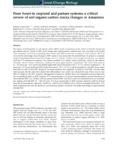Please use this identifier to cite or link to this item:
http://www.alice.cnptia.embrapa.br/alice/handle/doc/1036013Full metadata record
| DC Field | Value | Language |
|---|---|---|
| dc.contributor.author | FUJISAKI, K. | pt_BR |
| dc.contributor.author | PERRIN, A.-S. | pt_BR |
| dc.contributor.author | DESJARDINS, T. | pt_BR |
| dc.contributor.author | BERNOUX, M. | pt_BR |
| dc.contributor.author | BALBINO, L. C. | pt_BR |
| dc.contributor.author | BROSSARD, M. | pt_BR |
| dc.date.accessioned | 2016-02-03T11:11:11Z | pt_BR |
| dc.date.available | 2016-02-03T11:11:11Z | pt_BR |
| dc.date.created | 2016-02-03 | pt_BR |
| dc.date.issued | 2015 | pt_BR |
| dc.identifier.citation | Global Change Biology, v. 21, n. 7, p. 2773-2786, Jul. 2015. | pt_BR |
| dc.identifier.uri | http://www.alice.cnptia.embrapa.br/alice/handle/doc/1036013 | pt_BR |
| dc.description | Abstract - The impact of deforestation on soil organic carbon (SOC) stocks is important in the context of climate change and agricultural soil use. Trends of SOC stock changes after agroecosystem establishment vary according to the spatial scale considered, and factors explaining these trends may differ sometimes according to meta-analyses. We have reviewed the knowledge about changes in SOC stocks in Amazonia after the establishment of pasture or cropland, sought relationships between observed changes and soil, climatic variables and management practices, and synthesized the ?13C measured in pastures. Our dataset consisted of 21 studies mostly synchronic, across 52 sites (Brazil, Colombia, French Guiana, Suriname), totalling 70 forest?agroecosystem comparisons. We found that pastures (n = 52, mean age = 17.6 years) had slightly higher SOC stocks than forest (+6.8 ± 3.1 %), whereas croplands (n = 18, mean age = 8.7 years) had lower SOC stocks than forest (?8.5 ± 2.9 %). Annual precipitation and SOC stocks under forest had no effect on the SOC changes in the agroecosystems. For croplands, we found a lower SOC loss than other meta-analyses, but the short time period after deforestation here could have reduced this loss. There was no clear effect of tillage on the SOC response. Management of pastures, whether they were degraded/nominal/improved, had no significant effect on SOC response. ?13C measurements on 16 pasture chronosequences showed that decay of forest-derived SOC was variable, whereas pasture-derived SOC was less so and was characterized by an accumulation plateau of 20 Mg SOC ha?1 after 20 years. The large uncertainties in SOC response observed could be derived from the chronosequence approach, sensitive to natural soil variability and to human management practices. This study emphasizes the need for diachronic and long-term studies, associated with better knowledge of agroecosystem management. | pt_BR |
| dc.language.iso | por | pt_BR |
| dc.rights | openAccess | pt_BR |
| dc.subject | Annual crop | pt_BR |
| dc.subject | Carbon storage | pt_BR |
| dc.subject | Chronosequence | pt_BR |
| dc.subject | Grassland | pt_BR |
| dc.subject | Rainforest | pt_BR |
| dc.subject | Soil tillage | pt_BR |
| dc.title | From forest to cropland and pasture systems: a critical review of soil organic carbon stocks changes in Amazonia. | pt_BR |
| dc.type | Artigo de periódico | pt_BR |
| dc.date.updated | 2016-02-03T11:11:11Z | pt_BR |
| dc.subject.nalthesaurus | deforestation | pt_BR |
| dc.subject.nalthesaurus | humid tropics | pt_BR |
| dc.subject.nalthesaurus | soil organic matter | pt_BR |
| riaa.ainfo.id | 1036013 | pt_BR |
| riaa.ainfo.lastupdate | 2016-02-03 | pt_BR |
| dc.identifier.doi | http://doi.dx.org/1518-279710.1111/gcb.12906 | pt_BR |
| dc.contributor.institution | LUIZ CARLOS BALBINO, CPAC. | pt_BR |
| Appears in Collections: | Artigo em periódico indexado (CPAC)  | |
Files in This Item:
| File | Description | Size | Format | |
|---|---|---|---|---|
| BalbinoFromforest.pdf | 470,35 kB | Adobe PDF |  View/Open |









